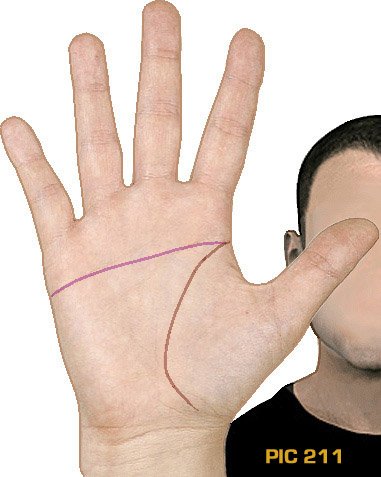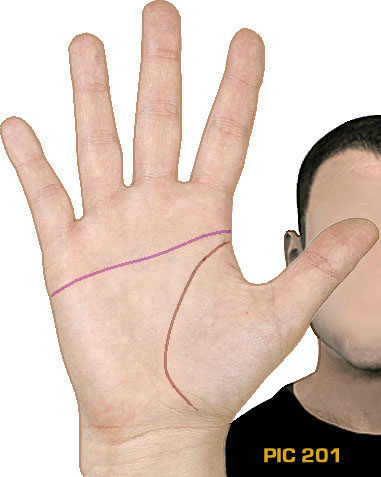November 22, 2018 - republication (REVISED: December 11, 2018)
- Big Five personality profiling: the Simian Line! -
Average simian line profile approaches Schizotypal profile based on the Big Five dimensions & it's meta-components
+ special attention for 'disconnected simian line variants'!
An in dept study focused on 15 simian line people (without transitional variants) shows that the average approaches the Schizotypal prototype (Dependent prototype is a close runner-up); 53,33% (8 out of 15) approach a prototype profile in the 'unstable & inflexible quadrant', and 53,33% (8 out of 15) have a protopype featured with a melancholic temperament.
![Psychological profile [ACSEO] for the simian line: average approaches the Schizotypal profile.](http://www.handresearch.com/picture/simian-line-ACSEO-profile-schizotypal.jpg)
Average scores for a (in)complete simian line population [N=15]:
Big Five dimensions: Agreeableness -10.0%, Conscientiousness -11.7%, (Emotional) Stability -26.7%, Extraversion -15.0%, Openness -1.7%;
META components: Cognitive efficiency -13.0%, ALPHA -16.1%, BETA -8.3%, Melancholic temperament
A = Agreeableness |
C = Conscientiousness |
N = Neuroticism |
E = Extraversion |
O = Openness


NOTICE: Included in the present study are only 15 simian line individuals (= 5,7% from a sample of 262 subjects) who's hands meet the criteria in one or both hands for a 'single crease' or a 'transitional single crease variant' (see picture above). This implicates that 6 other individuals assessed with a 'normal 4/simian 4' variation of the so-called 'transitional variants', have been excluded from this study (in order to avoid that arbitrary factors become involved whether such 'transitional variants' should be counted to represent a simian variant or a normal variant - especially, since in those variants the 'normal 1' structure is not missing!!!).
What are the implications of the simian line in the perspective of psychology? According medical science the single palmar crease can safely be regarded to represent a 'harmless minor physical anomaly' bearing merely statistical impact towards a wide range of medical issues, diseases and syndromes. The current in dept study shows a likewise statistical impact in the perspective of personality profiling, with results produced by individuals [N=15] which cover a large area of the full spectrum of possibilities in terms the so-called Big Five meta-components Alpha & Beta. However, a deeper analysis of the results does reveal a tendency towards low scores for Cognitive Efficacy, and a very consistent tendency towards a low score on at least one of the meta-components - only 1 out of 15 simian line individuals does not show this tendency, which illustrates that simian lines are by principle occasionally also found in personalities featured with both Cognitive Stability (Alpha) and Cognitive Flexibility (Beta).
The average Big Five profile of the studied simian line subjects approaches most closely the Schizotypal profile (out of 20 personality profiles): 2 out of 15 simian line individuals have a profile which approaches the Schizotypal prototype and 3 out of 15 simian line individuals have a Big Five profile which approaches the Dependent prototype - see meta-component chart presented at the top of this article. 8 Out of 15 simian liners (53,33%) have a prototype profile featured with a melancholic temperament; in only 3 out of 15 simian line people the prototype shows a match with the 'frame'.
The results of the present study, which relate to the perspective of normal behavior, is recognized to show a parallel with earlier reported results in the perspective of abnormal behavior. Because a relatively high simian line prevalence has been reported in studies focused on quite a few major psychiatric issues (such as: schizophrenia, psychotic behavior, developmental disorders & occasionally other forms of psychopathology such as Alzheimer disease). Curiously, the so-called 'Schizotypal personality disorder' (which involves a different phenomenon which should not get confused with a 'Schizotypal profile') is associated with a high risk for the development of psychotic behaviors.
A simian line in both hands vs. left- or right hand only
A small effect-size is also spotted for the variations in which hand(s) the (in)complete simian line is found. Subjects with a simian line in both hands appear inclined to have scores towards below average Cognitive Stability (= low Alpha); subjects with a simian line in the left hand appear inclined to have scores towards below average Cognitive Flexibility (= low Beta). And subjects with a simian line in the right hand only appear inclined to have scores towards the combination of below average Cognitive Stability and below average Cognitive Flexibility (= low Alpha & Beta).
A summary in terms of the distance from other profiles is presented below for each variation - with 'distance' representing the average square distance derived from the sum of 7 components: the individual Big Five dimensions + Alpha + Beta (using the summarized values for Alpha & Beta).
Schizotypal profile (0,57), Dependent profile (0,60), Antisocial profile (0,76), Borderline profile (0,90), Paranoid profile (1,36).
Narcissistic profile (0,54), Antisocial profile (0,56), Histrionic profile (0,77), Independent profile (1,39), Borderline profile (1,42).
Dependent profile (0,36), Schizotypal profile (0,55), Avoidant profile (0,61), Borderline profile (1,04), Antisocial profile (2,08).
Schizotypal profile (0,60), Schizoid profile (0,79), Non-theatrical profile (0,90), Unpretentious profile (1,76), Paranoid profile (1,92).

Remarkable phenomena in the distribution of simian lines cases among the Big Five profiles!
Various remarkable phenomena have been spotted involving the meta-groups and the individual profiles (for more details see the illustration at the bottom of this article):
• In the full research population [N=262] more than 1/4 of the subjects (30,5%) approach most closely a profile in meta-group 11; however, in the simian line sub-group only 1 out of the 15 cases (6,7%) approaches a profile in meta-group 11. The highest prevalence for the simian line sub-group is found in meta-group 2, where 8 out 15 cases are found: 53,3%, versus only 19,5% for the full research population.
• Also, 10 out 15 simian cases (66,66%) have a below average score for Cognitive Efficiency - versus 35,50% for the research full population.
• For individual profiles is the highest prevalence found for: the 'Narcissistic prototype' (14,3%) though this result is based on only 1 simian line case (who has a simian line in both hands), the 'Dependent prototype' (13,8%) based on 3 simian line cases (two have a simian line in both hands, one in the right hand only), the 'Paranoid prototype' (12,5%) based on 1 simian line case (in the right hand only), and the 'Schizotypal prototype' (7,7%) based on 2 simian line cases (one has a simian line in the right hand and one in the left hand). These four prototypes are located at a short distance from the total average simian line profile [T] marked inside the meta-component chart. However, in terms of the personality profile these 7 simian line cases show no clear similarities involving their Big Five profiles (they just have similarities in terms of meta-components + they have two below average scores on two Big Five dimensions that border with each other in the perspective of the ACSEO model).
• Another remarkable results involves the fact that all 4 subjects with a simian line in the right hand only are found in the meta-group 2
• In 3 out of 7 profiles of meta-group 2 to 4 the simian line group has a total prevalence of 12,5% or higher (versus none in meta-group 1 & meta-group 5 to 12).
• 26 out of 30 simian lines (= 86,7%) are found in the hands of individuals who have an Alpha score of 0 or below; this also involves 12 out 15 individuals in this study (=80,0%). This suggests that in the studies sample only 13,3% of the simian lines are found in the hands of individuals who have above average cognitive stability [= Alpha > 0]. All 3 simian line subjects with above average cognitive stability do NOT have a 'disconnected simian line' (more details on these variants are presented in the next section).
- Special attention for 'disconnected simian lines': large impact! -
A typical manifestation associated with simian lines is that in most cases the simian line is found connected with the radial longitudinal crease, a.k.a. the thenar crease (or the 'life line' in palmistry) - see PIC 211 displayed below. However, in some cases of a simian this connection is missing; such cases can be described to represent a 'disconnected' simian line - see PIC 201 displayed below.


In the studied sample represent 5 out of 15 simian line cases a 'disconnected' variant. An analysis of these cases reveals that the impact of these 5 'disconnected' simian line cases is relatively large, because 4 out of 5 cases (= 80%) of the 'disconnected' simian lines are found in the UNSTABLE & INFLEXIBLE QUADRANT. For the full sample only 8 out 15 cases (= 53,3%) are found in this quadrant.
Interestingly, there is also an additional simian line case which does have a simian line that connects with the radial longitudinal crease; however, it has a 'disconnected' proximal crease in the other hand. This case is also found in the UNSTABLE & INFLEXIBLE QUADRANT. This can be recognized to represent a similar phenomenon.
These additional findings suggest that persons who's hands are featured with a simian line combined with a 'disconnected' radial longitundinal crease in at least one hand, appear to have the highest probability to have a Big Five profile that is found in the UNSTABLE & INFLEXIBLE QUADRANT: in the studied sample this is true for 5 out of 6 cases (= 83,3%). While for the other 9 simian line cases this is true for only 3 out 9 cases (= 33%), which is according what can be expected by probability theory.
- What are the implications of this study? -
The impact of the simian line in the perspective of psychology appears to show a parallel with results reported in the perspective of medical science & psychiatry. Nevertheless, even though the simian line may bare value for groups of simian liners, the effect-size for groups is typically a matter of statistics - which implies that any of the reported tendencies for the full Big Five personality profile or any of the Big5 dimensions clearly does not apply to the full group of simian liners.
Also, the average Big Five profile shown in the picture at the top of this article suggests that the impact of the simian line is most likely most high for aspects of behavior involved with low scores for the Big Five dimension (Emotional) Stability, in other words: high scores for Neuroticism, which the counterbalance factor involved with (Emotional) Stability.
FINAL NOTIFICATION: Even though the palmistry literature has a folkloric tradition in supporting the belief that simian line bare specific value in the perspective of personality or behavior (though there is no consensus on this in the global palmistry community and many palmistry authors appear to cherish private perceptions on this matter), the results of this study do not support such beliefs because the variation of behavior among simian line people is very likely much larger than what is suggested by far most palmistry books (this also applies to literature with references to palm reading, hand reading, hand analysis, chirology, chirognomy, chiromancy, chirosophy, etc.).
![Distribution of people with strictly assessed simian line (without transitional variants) [N=15] versus controls [N=262] among 13 Big Five personality meta-groups!](http://www.handresearch.com/picture/distribution-big-five-personality-profiles-simian-line-strict-meta-groups-20.jpg)
SUGGESTIONS FOR FURTHER READING:
Discover the impact size of the simian line relative to other hand signs:
Major hand signs & the General Factor of Personality (a.k.a. 'Trait EQ')
A detailed description for each of the 39 Big Five profiles is presented in the article:
System for Big Five personality profile interpretation!
Summary of key-constellations in the Big Five personality dimensions:
Neuroticism, Openness, Extraversion, Agreeableness & Conscientiousness:
Hand sign constellations in the Big Five personality dimensions!
Next section:
• PSYCHODYNAMIC PROFILES: The simian line!